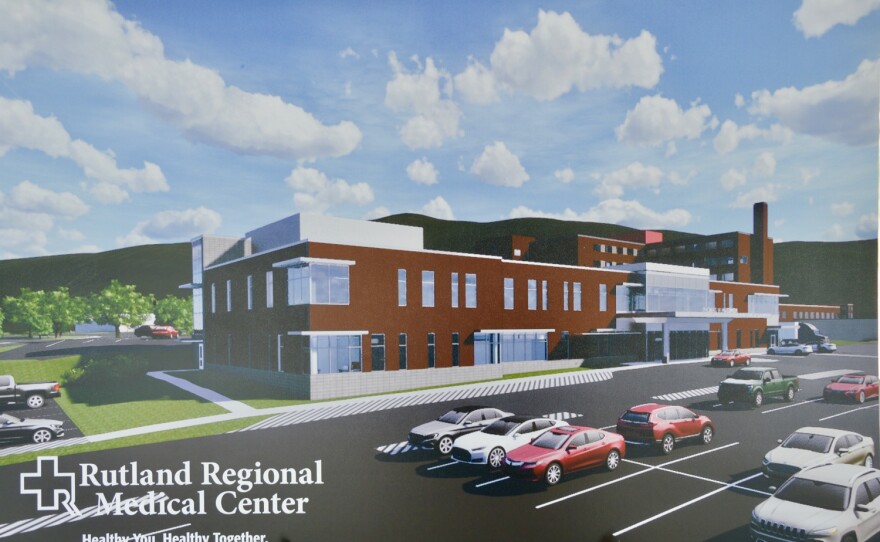Local and state officials were at Rutland Regional Medical Center Monday to celebrate the groundbreaking of a new $23.9 million medical office building. The new construction is coming at a time when many hospitals in the state are struggling financially. Rutland hospital officials acknowledge they're taking a calculated risk.
According to 2018 financial reports more than half of Vermont’s hospitals lost money last year. Springfield and Gifford are in especially tough shape.
Rutland Regional Medical Center, however, is one of six Vermont hospitals that has stayed in the black. But it’s margin – the gap between revenues and operating expenses - continues to shrink. Between 2017 and 2018 Rutland Regional’s margin went from more than $7 million to $1.3 million.
Despite that, the hospital is moving forward with a construction project that’s been years in the making – a new 37,000 square foot, two story office building that will house the orthopedic, audiology, physiatry and ear nose and throat departments. It will be named for former long time CEO Thomas Huebner, who retired last year after 28 years with the hospital.

Claudio Fort, Rutland Regional Medical Center’s President and CEO, said some might question if now is the right time to make this type of investment. “But the question we have to look at is what if we don’t build that building?” he asked.
Fort said failing to build the project would hurt the hospital's ability to attract qualified surgeons and specialists and would not address the demand for services - services that he said are growing in a county like Rutland’s, which skews older.
“For anyone you know who has had bad hips or a knee problem, if they don’t get these services, and we don’t have access for these services here, they’re going to go to Massachusetts or New York or New Hampshire to get those services," said Fort. "And that will just exacerbate some of the financial challenges we see.”
Fort said the hospital is borrowing money to pay for the new building which is scheduled to be completed in June 2020. The overall project will also include expanding and rennovating the hospital's loading dock, a portion of its dietary area and replacing the hospital's freight elevator.
Rutland Regional is the largest employer in the county - 1,700 people work there. Local officials including Mayor David Allaire and Mary Cohen, head of the Rutland Region Chamber of Commerce, said they're thrilled to see the project underway.
Fort is just finishing his first year as CEO. Before coming to Rutland, he led North Country hospital in Newport for 10 years. He acknowledged it’s a tough time for rural hospitals. While revenues have increased, he said labor and pharmaceutical costs have gone up even faster.
Drug prices, especially for diabetes medications and chemotherapy for cancer patients have risen dramatically.
In Rutland, as in many rural areas, Fort said finding enough doctors and nurses is an ongoing problem as well and demand is pushing up their salaries.
“Right now 15 percent of doctors at Rutland Regional are temporary hires, which are often costlier,” said Fort. He added, "Last year we were up to about 55 temporary staff nurses for this hospital, the highest it’s ever been. We’ve gotten that down to about 15 or 16, but it’s creeping back up again.”
Fort said they’ve developed a strong partnership with Castleton University to develop new nurses. He said the school also provides additional training for existing nurses. But the nursing shortage remains a problem.
The Green Mountain Care Board dictates how much hospital budgets in the state can grow each year and it issued a certificate of need for the Rutland expansion. Kevin Mullin, the board’s chairman, was in Rutland for Monday’s groundbreaking.
RRMC is in a good position financially, he said, but it hasn’t escaped the problems plaguing every other hospital in Vermont. “Rutland isn’t immune from the problem," Mullin said. "Rutland’s expenses have been growing faster than their revenues just like most other hospitals in the state. So when we issued the C-O-N (certificate of need) for this project we were really looking at the efficiencies it could bring. By bringing things off site onto the campus and trying to make Rutland Regional a more efficient operation than it already is.”
The good news, said Mullin, is Rutland's hospital is still operating in a positive margin. It's incumbent on the hospital’s board members to ensure that continues, he said, by addressing their rising operating expenses.






